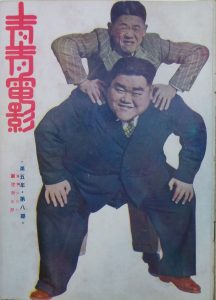For Educators

USE CHINESE FILM CLASSICS RESOURCES IN YOUR COURSES!
The Chinese Film Classics website offers free resources for educators and students of cinema, history, culture, and language. Here are a few ideas on how to make the most of it for your own purposes.
If you are using CFC films, please let me know here!
A FULL COURSE ON EARLY CHINESE CINEMA
The Chinese Film Classics online course offers a complete, semester-long online curriculum focusing on eleven black-and-white films. Each module includes one full film with English subtitles, two video lectures about the film and its historical and cinematic contexts, and an array of further viewings and readings. Students and teachers can use these materials, as a set or selectively, to create a self-paced learning experience.
MODULAR CONTENT
Films, video lectures, essays, image galleries, bibliographies and other resources can be used selectively based on interests and curricular needs. Encourage your students to browse the film scene index and follow their own interests. These self-study modules also free up more classroom time for group discussions and activities. Examples:
- A course on the history of Chinese cinema might incorporate one silent film, such as Goddess (1934), or a sound-on-disk film, such as The Great Road (1934), and one early sound film, such as Song at Midnight (1937) or Street Angels (1937)
- A course about women in modern China might include a module on visual representations of women, drawing on films such as Goddess (1934), New Women (1935), Hua Mu Lan (1937), or Long Live the Missus! (1947).
- A course on film form might use Goddess (1934) and Spring in a Small Town (1948) for modules on Mise-en-Scene or Cinematography; Sports Queen (1934) or New Women (1935) in a module on Editing; Street Angels (1937) or Spring in a Small Town (1948) in a module on Sound Design; Spring River Flows East (1947), Long Live the Missus! (1947) or Crows and Sparrows (1949) for a module on Plot; and City Scenes (1935) or Princess Iron Fan (1947) for a module on animation.
- A course on modern Chinese politics might feature one of three films that was made partly during the Republic of China and partly during the People’s Republic of China: Spring River Flows East (1947 [1956 re-edit]), Wanderings of Three-Hairs the Orphan (1949), Crows and Sparrows (1949).
THEMES AND TOPICS
You can design your own modules based on recurring themes and topics.
Here are just a few ideas, in alphabetical order:
- Celebrities and stardom
- Children
- The Chinese civil war
- Communism
- Confucianism
- Cultural industries
- Film form
- Gender
- Genre
- Humor and comedy
- Media
- Music and sound recording
- Performance styles
- Popular culture
- Poverty
- Revolution
- Sex
- Social norms
- Special effects
- Storytelling
- Urban and rural cultures
- World cinema
- World War II
PLAYLIST PEDAGOGY
This website and the companion Modern Chinese Cultural Studies YouTube channel offer an array of audio-visual content for teaching and learning, with over 150 full films, film clips, and videos. These materials can be used to design research projects and classroom activities, or simply to discover and explore new interests.
- Have students browse film clips and write a research paper about a theme, concern, or feature shared by several films.
- Assign groups of students to update a Wikipedia page entry about one film or filmmaker.
- Have students create a 3-minute video essay, in which they make an argument about a single film and post it on the course website.
- Have students create their own playlists using film clips from the channel.
Feel free to create your own YouTube channel and draw on MCCS channel videos create a unique playlist for your course. The possibilities are many!
CHINESE LANGUAGE-LEARNING
All of the films may be used for Chinese-language learning – reading, listening, speaking, some even for singing! With films, you can pause and repeat as needed. The characters onscreen are all Traditional Characters (fanti zi), which was the standard during the Republican era (1912-1949).
- Train your reading comprehension by reading the title cards (intertitles) on the silent films made up to 1935. If you need more time, you can always press pause!
- Read or sing along with the animated song lyrics in musicals such as The Great Road (1934), Street Angels (1937), Hua Mu Lan (1937), or Spring River Flows East (1947).
TRANSLATION STUDIES
The subtitles for these films were all completed in the 21st century and were peer-reviewed by experts in Chinese language and film history. Translators range from high school students to full professors. These films present an excellent opportunity for advanced language learners to hone their Chinese-language comprehension and English-expression skills.
- Compare how the 21st-century translations differ from the original bilingual Chinese-English subtitles in films such as Laborer’s Love (1922), Woman Warrior White Rose (1929), Woman Warrior of the Wild River 6: Rumble at Deerhorn Gully (1930), and Song of China (1935).
- See how linguistic jokes and puns were translated in Sports Queen (1934) and Crows and Sparrows (1949).
- Consider how screen-space factors might have influenced translator decisions about the length, duration, or placement of the subtitles in films such as Laborer’s Love (1922) or Spring Silkworms (1933).
- Interested in translating a film yourself? Contact the CFC project leader, Christopher Rea!
WHAT’S WORKING FOR YOU?
Have a suggestion? Spotted an error or omission? Have an idea for the (virtual) classroom? Willing to share best practices? Please contact me here!
This website serves a global audience and, in just a few months, has attracted visitors from over eighty-five countries. I appreciate any and all efforts to make this shared resource better. Join the many people who have contributed to the Chinese Film Classics project, who you can read about here.

